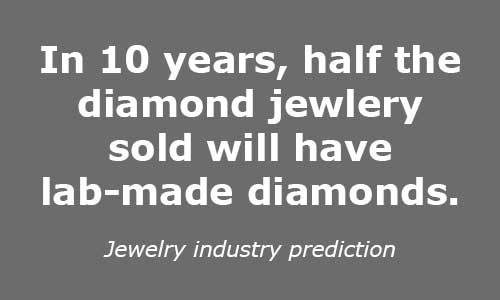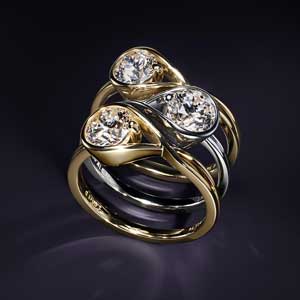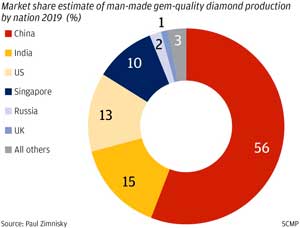Lab-Made Diamonds in the Fast Lane
In the realm of lab-made diamonds, things are moving fast. A few years ago we were talking about whether diamonds made in a lab were real diamond. That ship has sailed. Yes, lab-grown diamonds are real diamond.
They are widely produced, carried by more retailers, extensively advertised, and increasingly popular with consumers. And they are priced way lower than mined diamond.
All of that matters to jewelry insurers — today and going forward.
A short time ago less than 1% of diamond jewelry had lab-made stones. Diamond-growers were still working out the technology. Jewelers struggled with whether to even stock jewelry with lab-made diamond. Would customers buy it? Would they forgo the romance of diamond produced in the earth over millions of years, accepting instead a diamond made in a few weeks in a lab?
Fast-forward to today: The market share for lab-made diamonds is pushing 10%, and gaining. And of all the jewelry with lab-made diamond, a remarkable 80% is sold in the U.S.
Many jewelers carry both mined and lab-made diamonds, and some carry only lab-made stones. Online sites specializing in lab-grown diamonds entice customers with assurances that the gems are eco-friendly and climate neutral. Some sellers have begun separate lines of jewelry specifically to highlight lab-made diamonds.
Price
No doubt price is a major factor in the expanding popularity of lab-grown stones . Lab-grown diamond currently retails for between 30% and 75% below mined diamond of similar quality.
The lower prices have spurred a marketing shift. Designers and retailers are appealing not only to those buyers looking for lower prices on traditional jewelry, such as engagement rings. They are also promoting fashion jewelry to buyers who previously wouldn't have considered diamond jewelry because of the price of mined diamond.
As the earth's reserves of quality diamond are used up, the price of mined diamond may increase. Lab-made diamond, on the other hand, has a limitless supply, so its price may well continue to fall.
Some industry analysts predict that lab-grown diamond will eventually follow the model of De Beers' Lightbox, with $800 for a 1-carat diamond, $400 for a ½-carat diamond, etc.
NOTE:
Given the serious valuation difference between mined and lab-made diamonds, and the likelihood that prices of lab-grown diamonds will continue to drop, it is crucial for insurers to:
- KNOW whether a diamond you are insuring is mined or lab-made. That is, don't assume it's a high-value mined diamond.
- Keep valuations up to date, to keep premiums appropriate and to reflect the current market if a claim is made.
Appraisals
Not all lab-made diamonds are of uniform quality. Even De Beer's Lightbox, which initially did not grade its lab-made diamonds because "they're all the same," had to backpedal and change that approach. They now accept that consumers and insurers do want to know the quality — the 4 Cs — of the diamond being purchase and insured.
Each lab-made diamond is grown from an individual seed of diamond, and the seed passes on its characteristics to the newly formed diamond. A lab-grown diamond may even have inclusions. So each diamond, from a lab or from a mine, should have an appraisal for insurance.
NOTE:
Lab-made diamonds, like their mined counterparts, come in a range of quality and price. Some have brand names, others do not. Some come from reliable diamond producers, others are products of deliberate fraud trying to pass as higher value stones. GIA's grading labs have encountered a number of lab-made diamonds mixed in with parcels of mined diamond, prompting speculation that the producer's intent was to see if the stones would "pass" inspection and be graded as mined diamond.
Where are the diamond growers
Each year, 6-7 million carats of jewelry-grade diamond rough is produced worldwide.
There are diamond-growing labs all over the world, including in the U.S., but about half of the world's total production comes from China. Unfortunately for consumers and insurers, China is also the world's largest exporter of "imitation" jewelry — which includes fake brand-name jewelry, as well as jewelry made with low-quality gems, imitation gems, and fraudulently marked or unmarked metals.
India, where 90% of the world's mined diamonds are cut and polished, is also becoming a big player in lab-grown diamond. In a recent development, the Indian government formalized a policy to help finance diamond growers in order to stimulate exports. Industry analyst Paul Zimnisky said the move is "a significant catalyst and is likely to lead to a further boom in lab-grown diamond production volumes."
Internet shopping
Jewelry buyers no longer have to go shopping. Shopping comes to them. No set business hours, no time constraints, take as long as you like to browse and decide. View many samples on many sites. It's easy to compare prices — and lab-grown will come out less expensive.
Many sites allow you to "make your own ring." You choose the metal, the setting, the gem, the cut style, clarity and carat weight, and the cost is displayed. If it's too high, or if it's low enough that you can afford a bit more, adjust the qualities and components and immediately see the new price.
A ring is displayed that matches your criteria. Some sites show "your stone" in a 360-degree video. If you're still undecided, just put it in your cart to think about later.
Many sites are reputable sellers who provide accurate and complete information. Others may blur the valuation difference between mined and lab-made diamond. Sites like eBay and auction sites may offer poor quality diamonds (whether mined or lab-made), counting on consumers expecting bargains and being naïve about quality.
It is good practice for insurers to carefully review documentation of jewelry bought from such sites – and, in fact, from all jewelry sellers.
NOTE:
Many retailers emphasize that their diamonds are certified, and they include a lab report with the purchase. A future issue of JII will deal with some of the concerns around lab reports for lab-grown diamonds and "certified" stones.
FOR AGENTS & UNDERWRITERS
As lab-grown stones become more popular, jewelry is increasingly likely to have lab-made diamond.
 Don't assume a diamond is mined just because the appraisal doesn't say it's lab-grown. The appraisal should specifically state whether the stone is mined or lab-made. Be sure to read all the fine print on the appraisal form.
Don't assume a diamond is mined just because the appraisal doesn't say it's lab-grown. The appraisal should specifically state whether the stone is mined or lab-made. Be sure to read all the fine print on the appraisal form.
If lab-grown diamond is passed and priced as mined diamond, the appraisal valuation may be grossly inflated.
It's always best to ask for the sales receipt, which will more likely reflect the value of the jewelry. A large discrepancy between purchase price and valuation may indicate a lab-made diamond with mined-diamond valuation.
As technology improves and the production of lab-grown diamonds increases, their price will go down. At the same time, the supply of diamonds in the earth is limited, so values of mined diamonds may go up. The situation highlights the importance of keeping valuations up to date. This goes for policies already in place as well as for new coverage.
All scheduled jewelry should have an appraisal from a reliable and trained gemologist appraiser who is independent of the seller.
The best appraisal includes the JISO 78/79 appraisal form and is written by a qualified gemologist (GG, FGA+, or equivalent), preferably one who has additional insurance appraisal training. One course offering such additional training is the Certified Insurance Appraiser™ (CIA) course of the Jewelry Insurance Appraisal Institute.
Note:
Distinguishing lab-made diamond from mined diamond is beyond the training or technology of most gemologist appraisers. Only a grading lab with appropriate equipment can reliably make this determination. A future issue of JII will discuss Lab Reports.
FOR ADJUSTERS
Mined diamond has a substantially higher valuation than lab-made diamond. If the appraisal or lab report does not explicitly state whether the gem is mined or lab-grown, use every means possible to determine which it is. If possible, interview the seller!
Deliberate non-disclosure is always possible.
Gem-grading labs have received parcels with lab-grown diamonds mixed in with mined gems. How many lab-made stones have not been "caught" and are out in the marketplace being sold, and priced, as mined diamonds? The potential for fraud and overpayment on claims is enormous.
Sales receipts and proof-of-payment docs are often helpful in establishing whether a diamond is mined or lab-made. Read the fine print!
Take note of brand names on the docs, as some names may indicate producers or retailers of lab-made stones.
On a damage claim, ALWAYS have the jewelry examined in a gem lab that has reasonable equipment for the job and is operated by a trained gemologist (GG, FGA+ or equivalent), preferably one who has additional insurance appraisal training, such as a Certified Insurance Appraiser™.
Some lab-grown diamonds are inscribed with the name of the manufacturer, though others are not. An inscription may also identify a color-treated stone, identify a branded cut, or carry the lab report number. Although inscriptions can be removed, inscriptions that remain may supply important value information that could be missing from the appraisal—and such inscriptions are visible only under 10-power magnification.
©2000-2024, JCRS Inland Marine Solutions, Inc. All Rights Reserved. www.jcrs.com




